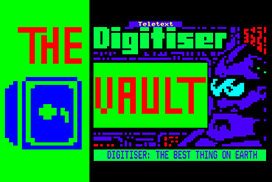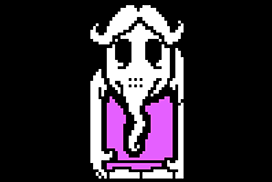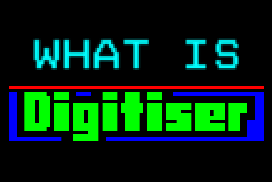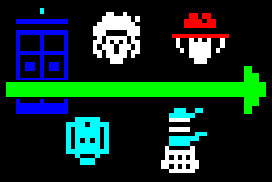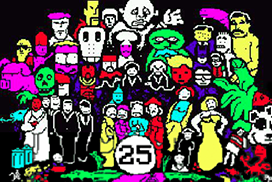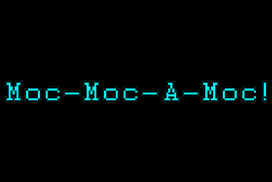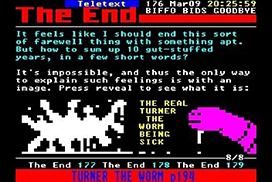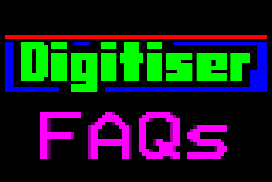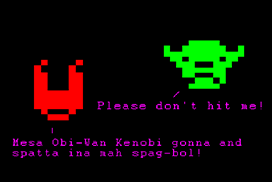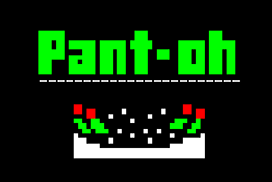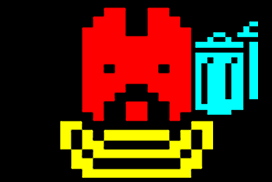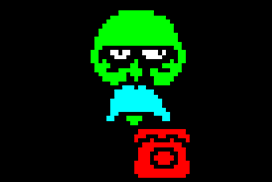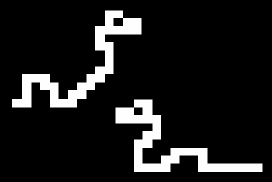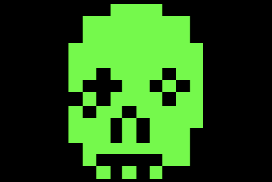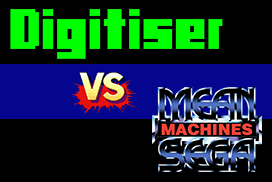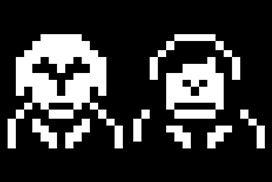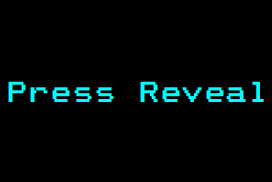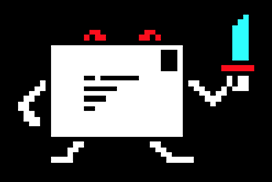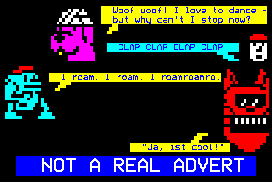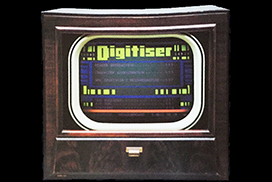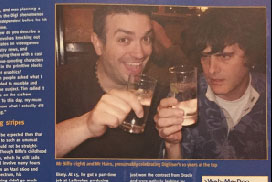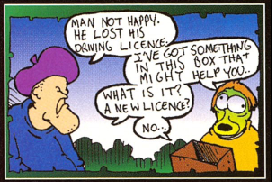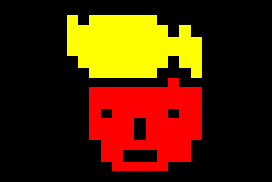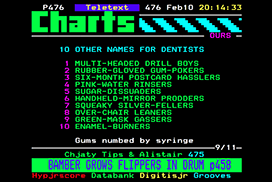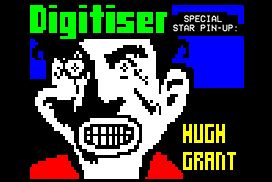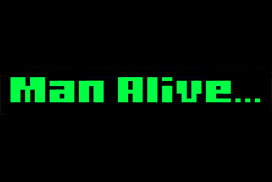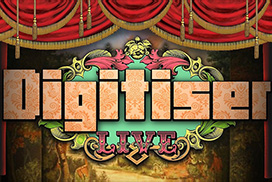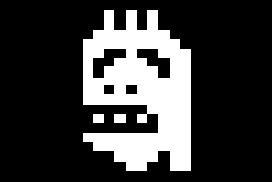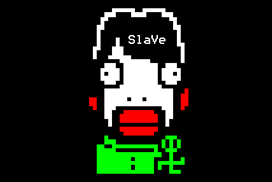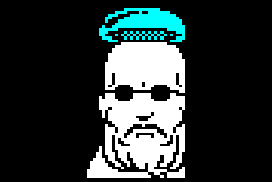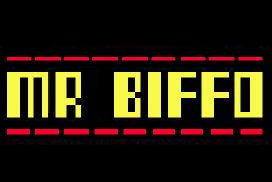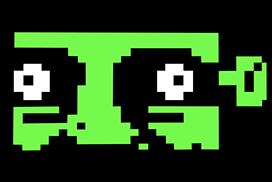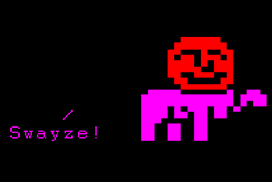
It seems you've landed on a website that's all about Digitiser, but aren't entirely sure what Digitiser is – well, welcome, then. Let's see if we can enlighten you a little, and beckon you further down this most bizarre of rabbit holes…
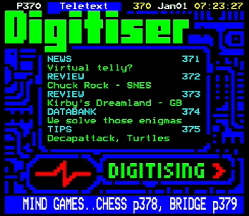
|
Digitiser was originally a daily computer and video games magazine, broadcast on UK teletext from 1 January 1993 to 9 March 2003. It continues today as a YouTube channel, and formerly a website.
It launched along with the new service provided by Teletext Ltd, following the loss of the ITV and Channel 4 teletext franchise by Oracle, which ceased broadcasting on 31 December 1992.
At its height Digitiser boasted 1.5 million readers per week, and was beloved by fans for its surreal, subversive humour, with more than a touch of innuendo; along with the striking quality and honesty of its games journalism. It has sometimes been likened to the work of Monty Python and Reeves & Mortimer.
Affectionately known as Digi to its fans and among the writing team, it started life broadcast on ITV, but was quickly moved to Channel 4 as part of an editorial shake-up by Teletext Ltd. It remained there for the rest of its run.
Written and created by Paul Rose ('Mr Biffo') and Tim Moore ('Mr Hairs'), the duo were the creative engine of Digitiser. The core writers were supported over the years by 'Mr Cheese' (Adam Keeble), who was brought in to write Amiga reviews, and later 'Mr Udders' (Gavin Lambert), and 'Mr Toast' (known only as 'Sean'), who solely handled the tips and chart pages. The writers' real names were never once used onscreen throughout Digitiser's 10 years on air.
Guest columnists from the games industry also contributed articles at weekends, most significantly Bad Influence TV presenter Violet Berlin, Edge editor Tony Mott, and Amiga Power's Stuart Campbell.
Early days
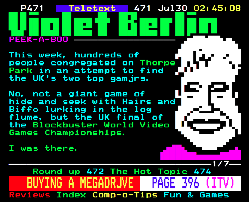
|
This manifested itself as uniquely strange humour and graphics being published on Digitiser's pages, completely unrelated to video games. Teletext being a particularly dry, largely personality-free outpost of journalism, this made Digitiser stick out a mile from the rest of the service's output.
Digi was soon just as well known for its odd, idiosyncratic humour as it was for its highly-regarded journalistic output. Indeed, the humour became just as popular with readers as the games content, if not more so, seeing the magazine retain a proportion of non-games fans among its readership.
Digitiser had been an instant success, and one of the most popular sections on Teletext immediately from launch, so this was not an insignificant number of readers. At a time when leading print-based games magazines had circulations of around 130,000 per month, 1.5 million readers per week was unheard of, indicating that it had a reach well beyond the games-playing public alone.
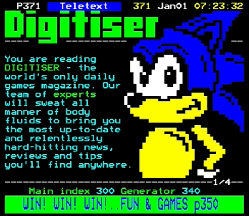
|
Biffo, originally hired as one of Teletext's graphic designers and responsible for large swathes of the service's visuals, was new to writing, but had an encyclopedic knowledge of video games, and an imagination that was never short of ideas. With his lack of professional training as a writer, he brought a freewheeling, original approach to proceedings, and used his graphics skills to provide Digitiser's memorable look and huge cast of characters - for which it became synonymous.
Hairs, on the other hand, was an established journalist. Slightly older than Biffo, he'd already written for Melody Maker and a string of other publications, bringing the professional experience and structure required to make the unencumbered chaos of Digitiser work, and hang together as a whole.
An accomplished writer with a dry wit and knack for a memorable turn of phrase, Hairs was the ideal writing partner for Biffo and his creative spark. The two men shared a similar appreciation for the absurd, and complimented each other brilliantly. Digitiser wouldn't have had the style, personality, or become the phenomenon that it would grow into, without either one of them being involved from the outset.
Controversy
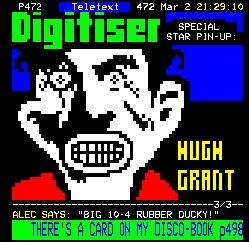
|
This started on the very first day of Digi's life when the decision to eschew the Commodore Amiga from their coverage resulted in a deluge of angry letters and phone calls from irate Amiga-owners, demanding that the writers be sacked.
Believing – arguably correctly – that the Amiga was a dying format, Digi were unrepentant, but relented essentially to stop the complaints. Amiga coverage became part of the line-up, though the writers never missed an opportunity to make fun of the format, ever to the annoyance of the vociferously humour-free contingent of the system's army of owners.
They weren't the only ones to take issue with Digi. Being so markedly different and divisive – and due to the writers' rebellious nature, wilful obstinacy, and general love of winding people up – Digi had plenty of enemies both in the industry, and within Teletext Ltd. itself.
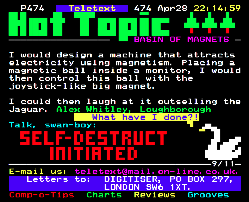
|
Starting in 1993 with a run-in with the tabloid press ("Teletext rapped for sick videogame joke", screamed The Sun in response to an inoccuous comment in a review), and through a series of other high-profile incidents, Digitiser and its writers gained a reputation for being trouble-makers - to be watched and treated with suspicion.
Sub-editors were told to scrutinise material prior to broadcast, and many became paranoid about the content they were reviewing, seeing innuendo and risqué humour where there was none. In some cases, this led to perfectly innocent writing not being run for fear of missing a joke that had gone over the sub-editors' heads. Later, entire paragraphs were excised from articles without being replaced – simply leaving empty, blank space on the page.
This antagonistic relationship with the higher-ups prompted management to secretly try to replace the writing team. In a time before email, physical memos were circulated stating these plans – which Biffo and Hairs stumbled across. "Just because you're paranoid, doesn't mean someone's not out to get you", Biffo would later say.
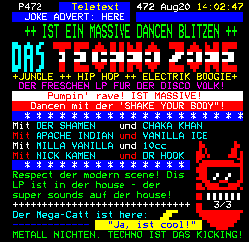
|
With Teletext believing that Hairs was the cause of the trouble, and leading an impressionable Biffo astray, events conspired in the spring of 1996 to allow the team to be broken up.
While Biffo was away on paternity leave, Hairs ran a news story alleging that high-profile games magazine editor Dave Perry had been reprimanded by his publishers for poor sales figures. Perry saw the story and immediately threatened legal action, prompting it to be pulled from air. In journalistic circles, this is taken as an admission of guilt - Hairs was summarily dismissed by Teletext and escorted by security out of the building and to his bicycle. But not before he'd loudly announced his departure to the office, throwing coffee over his computer as he went, regretting not being able to put the graphic of an erect cock on the Teletext index screen in retaliation, which the team had prepared for just such an occasion.
Dave Perry later admitted that the story had in fact been true.
Outsiders
There have been plenty of other examples of friction between Digitiser and the games industry. From the rude graffiti drawn on a Sega rep's notepad when he was out of the room, to the calling-out on air of Sony's PR manager for failing to provide them with a review copy of a PlayStation, it's fair to say that they had a reputation that carried far and wide.
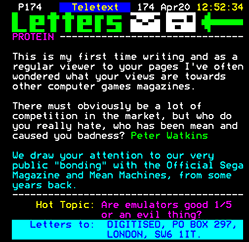
|
The most explosive and long-running example of this was the feud that started up between Digi and best-selling print games mag, Mean Machines Sega. As is explored in detail elsewhere on this site, Digi and MMS spent much of 1994 and 1995 at each other's throats, with a tit-for-tat war of words raging on the pages of both publications.
This animosity reached boiling point when MMS printed a reader-drawn cartoon ridiculing the Digi team. Never ones to refuse a pointless fight if they found it funny, Digi stepped up the put-downs, and sent MMS a series of faxes, attaching industry viewing figures as proof of how many readers they had. And to call the MMS editor a "fish-back" with "biscuit skin" - which may have been more the motivation for the exercise.
It soon dawned on Digi that MMS appeared to be taking the feud far more seriously than they were – Digi were essentially trolling MMS for the hell of it – and the matter was put aside seemingly as quickly as it started.
Part of the antipathy towards Digitiser within the games industry came from their unflinching editorial honesty and scrupulously fair and objective reviews.
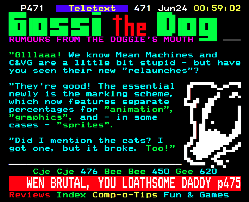
|
With most rival magazines being heavily reliant on advertising sales from games publishers, this was often used as leverage over review scores, artificially inflating ratings given to high-profile games, lest the ad revenue be pulled. Not having this same reliance, due to the archaic nature of teletext making it unattractive to advertising from games publishers, and the parent company's alternative revenue streams, Digitiser was free to be as honest – and rude – about games as they saw fit.
Famously, they scandalised a generation of Mega Drive owners by giving Sonic 3 a score of 72%, and dismissed Electronic Arts' 3DO racer Need For Speed with the damning phrase "You just drive about, man!"
Combined with their reputation for unflattering reviews and contrariness – along with teletext's inability to display screenshots of games - publishers and the industry at large viewed Digitiser with a combination of suspicion, scorn, and apprehension. It was often difficult for the team to secure review copies of games, they would be left out of press trips, and were generally seen as outsiders to be wary of. Ironically, this just gave them the platform and confidence to continue behaving rebelliously.
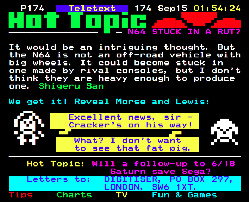
|
Reviews and features that were searing in their honesty prompted a steady stream of complaints from readers, accusing Digi of bias against one system or another. This began during the 16-bit console era with readers decrying Digi for their perceived favouritism towards Nintendo, and 'unfair' criticism of Sega (something which had fuelled the Mean Machines feud).
In a sign that Digi had in fact got the balance right, they would later be accused of bias for or against every major format, sometimes simultaneously, on the same letters page. History repeated itself during the Sony/Microsoft era with the same old arguments rearing their heads – often saying more about the insecurity of the systems' owners than anything about editorial bias.
As Digi replied in response to these frothing, irate readers - "we hate everyone equally, man".
Hallmarks
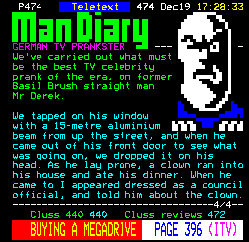
|
Hitting on an especially fertile seam, Biffo used this opportunity to introduce a string of classic Digitiser characters, resulting in probably its best-remembered era among fans over the next few years.
The bizarre array of characters that made their homes on Digitiser's pages had always been an integral part of its personality and appeal.
Starting with mascot The Man With A Long Chin (later shortened to simply 'The Man') in 1993, new characters would be introduced all the time, resulting in a cast of hundreds. During this period, The Man's Daddy (a "popular comedian" and purveyor of ridiculously nonsensical non-sequitur jokes) was brought back as a regular fixture, and joined the likes of The Snakes (street-talking teenagers who just happened to be reptiles), Zombie Dave (a shambling reanimated corpse who commented on the news by disguising outrageous innuendo within his moans), The Rapping Shoe (a hip-hop star and lovable brogue), along with weird parodies of 'A-Team' tough-guy Mr T, and star of ITV police dramas, Inspector Morse.
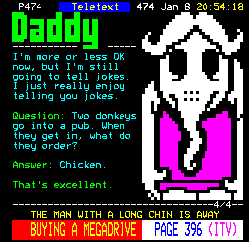
|
Many of these characters were at first hidden from view, but could be displayed by pressing the 'reveal' button on teletext-equipped TV remotes. This would display the rudimentary images or message in previously blank space on the page, and this function was often used to highly comic effect. The feature became such an integral part of Digitiser that the words "press reveal" became a well-known catchphrase.
Other catchphrases would develop over the years and be taken up by readers on the letters page and within the fan community. This started with The Man's "Nubby nubby nubby!", his arch enemy The Fear Taunter's cries of "Nun-nun-cha!" and "Chal-ning-ning!", proceeded through Mr T's angry cries of "Stay away from my bins!", and onto The Snakes' sneering "I cuss you bad".
Characters weren't the only source of catchphrases, as Digi's writing itself yielded some of the most iconic examples. Random exclamations of "Swayze!", or a disapproving "huss!" littered its pages, but none are more well-regarded than the immortal "Do you see?" and "Moc-moc-a-moc!".
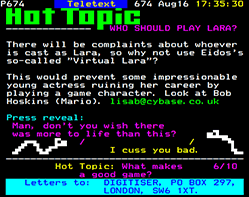
|
The former was often used after making an off-kilter joke, obtuse reference, or as part of a withering reply to a particularly foolish reader on the letters page. "Moc-moc-a-moc!", meanwhile, has become legendary. Completely nonsensical, it has no particular meaning, or is used in any particular circumstances - it's a gibberish phrase exclaimed with joyful exuberance by various strange reveal-o-characters, and has become a cornerstone of the Digitiser lexicon.
Language itself – and the warped use of it – has always been one of Digitiser's primary calling-cards. From the very earliest days it was apparent to readers that there was something strangely 'other' about the way Digitiser was written, and this only became more pronounced and unusual as time went on.
From filling the space at the end of a page with random cries of "And!" without any kind of explanation, to the strange juxtaposition of words and situations that had seemingly no business being put together; the overly-familiar way they would refer to readers as "love" and "dear"; or the way things would be described as "'x'-me-do" (e.g. "cuss-me-do" used to describe something negatively), reading Digitiser was an experience like no other.
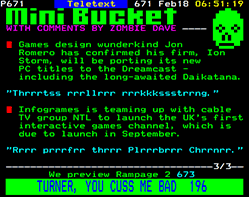
|
This particular idiom made such an impression that it inspired the name of this website ("Super Page 58" was chosen as Digi would often refer to something as being "super-THING-NUMBER" for comedic effect).
Digi interacted with their readers on the letters page with remarks which became catchphrases themselves ("Best work yet!" if a letter met with approval, "You have messed-up" if it… didn't).
Punctuation was another part of this, often used in unexpected places or unusual ways - the feature "Old Game: Here" and the competition "Digitiser = Filth" being prominent examples of this.
Digitiser's unique shared language made it stand out from any other magazines, either in print or elsewhere on Teletext, and gave its fans a lexicon of their own which allowed them to feel part of a community.
Digigate
The passionate fanbase Digi had built over the years showed their devotion during the controversial events of 2001 and 2002 - a notorious period that would come to be known as 'Digigate'.
The knives had been out for Biffo and Digi at Teletext for many years. Management had long sought a way to bring the maverick section to heel, and they contrived to bring that about in October 2001.
Using the loss of holiday advertising revenue due to the 9/11 terrorist attacks as an excuse, Teletext management decreed that Digitiser be reduced from daily editions, to only three days per week – though curiously, publishing the same amount of material as before. Worse still, they demanded that Biffo strip Digi of "Monty Python-esque humour" (in the words of the Teletext boss that Biffo has since described as "needlessly aggressive and nasty"), because it apparently "excluded people".
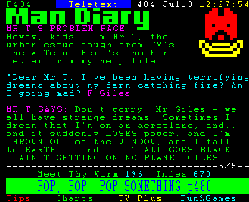
|
Apparently, the humour didn't in fact exclude people, as shortly after Biffo was forced to make the changes, the magazine shed around 800,000 readers. Ironically, as a section that made a fair amount of advertising money for Teletext, this would have hurt the company in the coffers even more, rather than saving them money as (spuriously) intended.
The fans weren't inclined to take this lying down, however, and were understandably outraged at the personality-free, humourless imposter that was now calling itself 'Digitiser'. A grassroots campaign began to have it restored to its former glory, and letters dropped on Teletext in droves. Choice selections of these were picked out by Mr Udders and shown to Biffo to help keep his spirits up, and let him know that he hadn't been forgotten - Digi's readers weren't letting it go quietly.
This war of attrition continued unabated for many months, lasting deep into 2002. Finally, Teletext admitted defeat in the autumn of that year – telling Biffo they'd been wrong to axe Digi's humour, and asking if he'd please restore it to its old, much-loved (and money-making) self. He gladly obliged, and Digi gradually began to see its idiosyncratic humour return from November 2002 onwards – though its characters wouldn't reappear until 2003.
Then came a fateful misunderstanding.
Biffo had been starting to break into the TV writing industry, having begun writing comedy scripts with Hairs in 1996 as a means to keep working together after the latter's sacking. Hairs was now a successful travel writer, and Biffo was seeing scriptwriting success of his own.
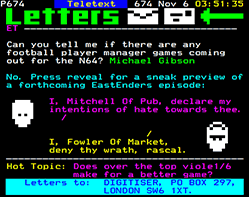
|
Having heard rumblings that Digi was in trouble again, Udders phoned Biffo to warn him. Sure enough, a phone call soon came through from Teletext asking Biffo to come into the office for another meeting. Sick of being messed around, and having been offered a writing gig on the BBC's flagship soap opera, EastEnders, and therefore not so reliant on the money from producing Digi, he instead announced his resignation.
After a pause, the Teletext manager informed Biffo that, actually, they were planning to expand the section and commit to persuing the lucrative 18-25 market, which they believed Digi to be the perfect vehicle for.
Biffo was shocked by this revelation, but immediately realised his initial instincts rang true - that it probably was time to move on - and stuck to his guns.
The decision was made. Digitiser would end.
The End
Digitiser was coming to the conclusion of its long run on Teletext. But the Digigate war had been won - the humour had been restored. And it had a little celebrating to do.
Happily, this coincided with the 10th anniversary of Digitiser on 1 January 2003, which was marked with a fine tribute by celebrity fan Alex Garland.
The curtain would finally fall in March, with the last weeks some of the funniest, most strongly-remembered – and notorious – in its history. Seemingly every reveal-o-joke took on a suspiciously phallic look. Digi was going out with a bang – or should that be 'climax'?
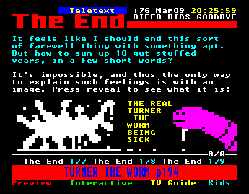
|
Yes, The Real Turner The Worm Being Sick – the reveal-o-joke to end all reveal-o-jokes – will seemingly be the one image most associated with Digitiser for ever more. A hilarious depiction of cartoon character Turner The Worm (which Biffo had written and drawn for Teletext's Kids section for the last 10 years) - reimagined as a fittingly garish spunking cock - was shocking and funny beyond measure, even to seasoned Digitiser fans. That Teletext's sub-editors allowed it to be broadcast in these circumstances is to their credit – a timeless legend was born, and they didn't even receive a single complaint.
One spectacular leaving party with the core writing team and a whole load of fans present later, and Digitiser was gone from Teletext after 10 eventful, anarchic years.
Ironically, it was only now that Biffo came to appreciate the level of affection in which Digi was held by its fans, and just how much it had meant to them. High readership figures are one thing, but it had only seemed real to him once he'd actually met a number of these fans and heard about their love of Digi first-hand.
Rebirth
Following the end of Digi on Teletext, Biffo forged a successful scriptwriting career for himself and dropped the 'Mr Biffo' alter ego for some time. But he couldn't stay away forever.
In 2014, he returned to Digitiser, launching it as website Digitiser2000, trademarked Digitiser in 2018, and grew a whole new generation of fans.
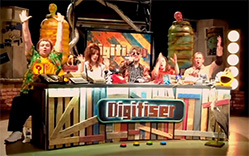
|
The community that built up since its online return has rivalled the Teletext era of Digitiser for the passion and dedication of its fans, if not in the same million-strong numbers. It also enabled Biffo to produce ground-breaking, ambitious Kickstarter-funded YouTube series in the form of Mr Biffo's Found Footage and Digitiser The Show.
In July 2019, the show took to the boards, with the spectacular Digitiser Live event, that will live long in the memories of all who saw it.
Digitiser's story has been at times hilarious, ridiculous, absurd, tragic - and somehow, for something so unlikely - even strangely meaningful and inspiring, in its odd way.
There has never been anything like Digitiser before, and it's difficult to imagine how anything like it could ever happen again.
Digipochs
The eras of Digitiser's life can broadly be classified into the following periods:
1. Launch – January to March 1993
Finding their feet, getting to grips with the format, and figuring out what Digitiser was.
2. Early days – March 1993 to late-1994
The first characters appear, Digi's strange humour starts to surface, many of the hallmarks and tropes take root.
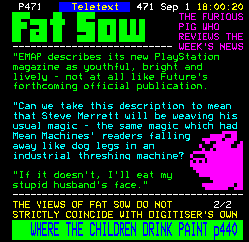
|
3. Established – early 1995 to spring 1996
Regular features like Old Game: Here and Ring-sir! are in place, while long-running characters including Fat Sow, Gossi The Dog and The Man's Daddy get their debut. Digi is confidently itself, has its own voice and knows what it is.
4. Phase 2 – spring 1996 to late 1997
Biffo takes the reins solo following the sacking of Hairs, and rises to the occasion by turning up the weirdness levels.
5. Golden Age – early 1998 to mid-2000
Arguably the most popular and best-remembered period, some of Digi's most famous characters are introduced, and the reveal button comes into its own in a big way.
6. Late period – mid-2000 to October 2001
Digi has matured into a long-established organ; spoof scripts are published in place of Man Diaries more regularly as Biffo's scriptwriting career starts to take off, popular characters get extended multi-page adventures.
7. Digigate – October 2001 to November 2002
Teletext bosses order Biffo to remove all of the humour from Digi, sucking out the personality and losing 800,000 readers in the process. A dark time for all concerned.
8. Restoration – November 2002 to March 2003
Teletext realise their mistake, apologise to Biffo and ask him to reinstate the humour. The final months of Digi's life are hilarious, explosive, and notoriously memorable.
9. Rebirth – November 2014 to present
Biffo decides to return to Digi, rebooting it as a website and writing under the 'Mr Biffo' name for the first time in six years, and goes onto produce Kickstarter-backed video series, Mr Biffo's Found Footage and Digitiser The Show. Digi goes from strength to strength, forges a welcoming online community, and attracts a legion of new fans.
Further information
Digitiser Timeline of Events – the complete history as it unfolded
The Digitiser/Mean Machines Sega Feud – a detailed look at the print-based fisticuffs
Do You See? – the Digitiser encyclopedia
The Digitiser Vault – over 8,000 images from more than 600 editions of Digi
Edge magazine feature on Digi
Retro Gamer magazine feature on Digi
Digitiser Characters A-Z
Digitiser The Show: Secret Origins Of Digitiser
Mr Biffo's memoirs, on Digitiser 2000:
Games of My Years: 16-BIT Part 1
Games of My Years: 16-BIT Part 2
Games of My Years: Digitiser Part 1
Games of My Years: Digitiser Part 2
Games of My Years: Digitiser Part 3
Games of My Years: Digitiser Part 4
Games of My Years: Digitiser Part 5
Games of My Years: Digitiser Part 6
Games of My Years: Digitiser Part 7
Games of My Years: Digitiser Part 8
Games of My Years: Digitiser Part 9
Games of My Years: Digitiser Part 10
Games of My Years: Digitiser Part 11
Do you know of any important moments from the annals of Digi history that have been omitted? If so, then mail me (superpage58@gmail.com) right now, man. Credit will be duly given for anything that gets put up.


